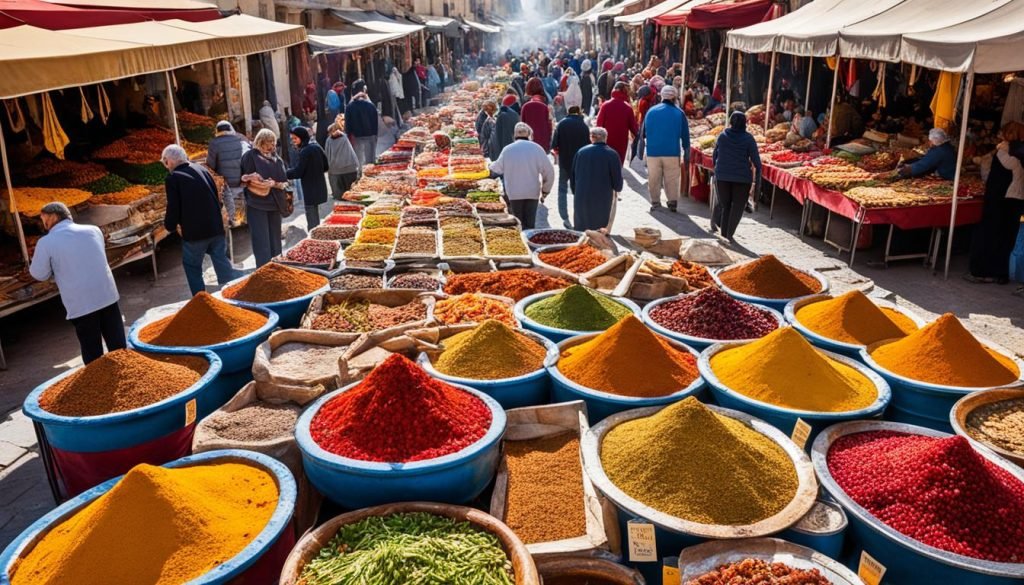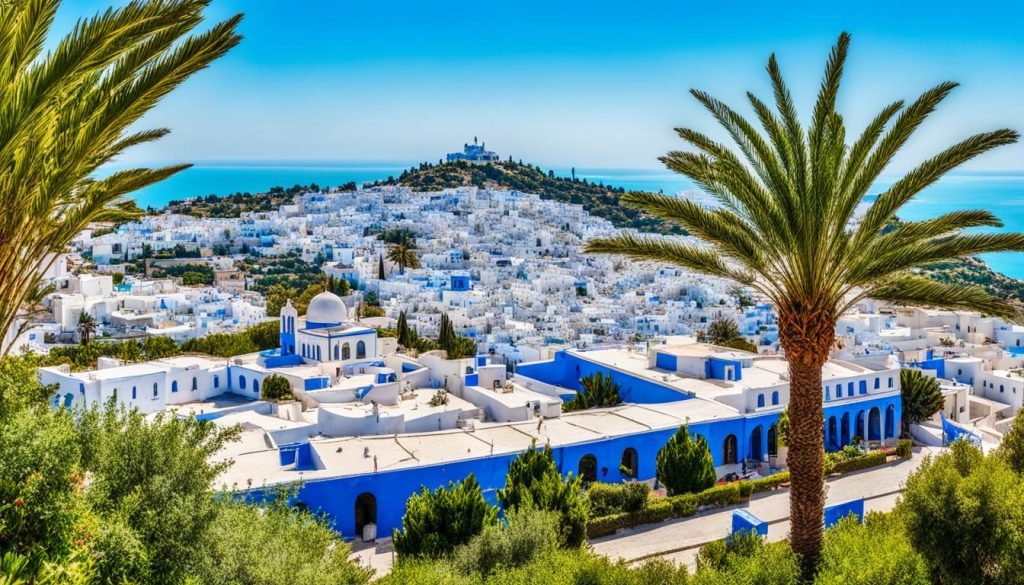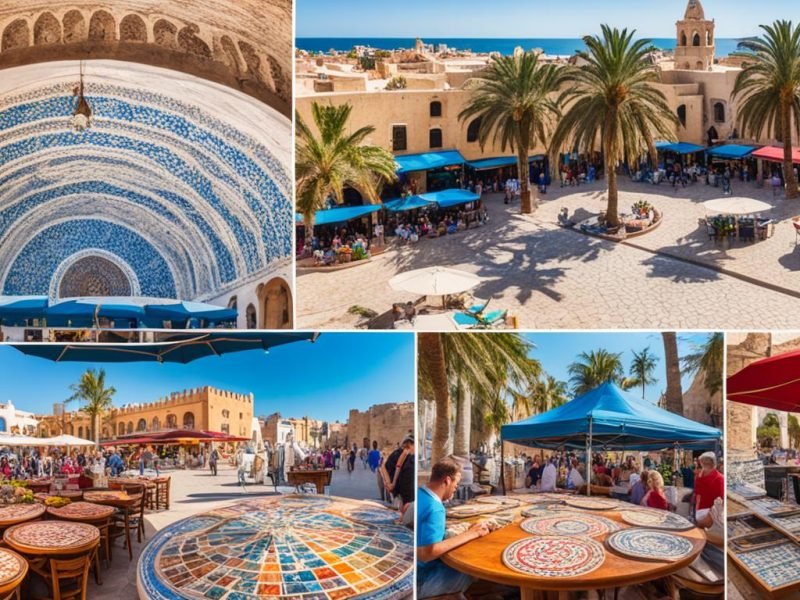Did you know Tunisia welcomed over seven million visitors in 2019? It is now seen as a hidden gem in North Africa. It boasts a rich heritage, stunning places, and yummy food.
Last year, I explored Tunisia and found many historical sites. Places like the ancient ruins of Carthage and the El Djem Amphitheater. The beaches are beautiful, and the culture vibrant. You’ll see this in the busy souks of Tunis and in the local arts and crafts.
Key Takeaways
- Tunisia welcomed over seven million tourists in 2019, a testament to its growing appeal.
- The ancient city of Carthage is a cornerstone of Tunisian history, showcasing spectacular ruins.
- El Djem Amphitheater, a UNESCO World Heritage Site, is a marvel of ancient architecture.
- The Medina of Tunis offers a unique glimpse into the cultural heartbeat of Tunisia.
- The Mediterranean coastline boasts stunning beaches in locations such as Djerba and Hammamet.
- Tunisian cuisine, featuring dishes like Brik and Harissa paste, is a gastronomic delight.
The Ancient City of Carthage
The ruins of Carthage are near Tunis and very important to Tunisian history. They show us lots about the Carthaginian civilisation. They highlight its big role in Mediterranean history. Carthage, as an open-air museum, shows us a time that greatly influenced the area’s culture and history.
The Ruins of Carthage
Visitors to this historic site can see the remains of Carthage’s civilization. The ancient buildings offer a peek into the past. They show the people’s skill in building and how they lived. Each piece of stone at the site has a story. It tells of Carthage’s big impact on history, making it great for history lovers.
Baths of Antoninus
Seeing the Baths of Antoninus is a must when in Carthage. They are among the best-preserved Roman baths. These baths take us back in time. They show where different social classes met in luxury. The Roman and Carthaginian worlds come together here. This mix shows the strong impact these cultures had on the area.
| Site | Significance |
|---|---|
| The Ruins of Carthage | Showcase the depth and influence of Carthaginian civilisation in Mediterranean history |
| Baths of Antoninus | One of the world’s best-preserved Roman bath complexes, illustrating Roman influence |
El Djem Amphitheater
The El Djem Amphitheatre is a top landmark in Tunisia. It shows ancient Roman skill. It wows us with its beauty and smart Roman engineering.
UNESCO Heritage Site
It is a UNESCO World Heritage Site. This means it’s very important to keep safe. El Djem is quieter than Rome’s amphitheatre. It lets you explore ancient buildings calmly. It could hold 35,000 people, showing it was a huge Roman amphitheatre.
Architectural Marvel
The El Djem Amphitheatre is cleverly designed. It has secret passages and smart seating. These show Roman engineering was advanced. Walking through, I was amazed by its size and design. It stands out as a Tunisian landmark. It keeps ancient architecture alive in a stunning way.
Tunisian Cuisine Delights
Tunisian food makes your taste buds dance with joy. It mixes tastes and textures in an amazing way. You can try many unique dishes that show the country’s culture. Iconic in Tunisian street food are Brik and spicy Harissa paste.
Brik
Brik is a must-try in Tunisia. It’s a tasty pastry that surprises you with each bite. Inside, you find a soft egg with tuna or capers. Brik is loved on busy streets and in restaurants. It shows off Tunisia’s love for food.

Harissa Paste
Harissa paste is key in Tunisian meals. This hot sauce is a must in many local dishes. It makes dishes exciting with its bold heat. It adds a special touch to Tunisian and other Eastern foods.
Tunisia’s food scene is exciting. It combines tradition with local items. You’ll love the crunchy Brik or spicy Harissa. Trying Tunisian street food is a great adventure for food lovers.
The Medina of Tunis
The Medina of Tunis is the heart of Tunisia’s capital. It’s a place full of history and tradition. Here, you can see beautiful buildings and busy marketplaces. Each corner tells a story of Tunisian culture.
Cultural Heartbeat
As you walk in the Medina, you feel history all around. You will see many shops. They sell Tunisian arts and tasty street foods. The buildings are beautiful, with special designs. This shows the deep culture of the place.
Bustling Souks
The busy markets show the Medina’s lively spirit. They are full of many things to see and buy. You can find lovely textiles and spices. Shopping here is like exploring Tunisian life and traditions.
Stunning Beaches on the Mediterranean Coastline
Tunisia is loved for its sunny Mediterranean coastline. It’s a top pick for those loving the sun. Its beautiful Tunisian beaches are unique compared to common Mediterranean places. My time there was filled with both chill moments and fun adventures.
Djerba
Djerba is an island with relaxing beaches and rich culture. It’s great for a slow-paced holiday but still offers local experiences. Walking on Djerba’s sandy beaches feels magical. It’s a highlight in Mediterranean travel.
Hammamet
Hammamet is full of lively water sports and beach clubs. It’s perfect for active sun-lovers. I spent a week in Sousse and loved Tunisia’s beach vibe. Even in October, the water was warm for swimming. Djerba’s calm and Hammamet’s energy show Tunisia’s variety.
Sidi Bou Said
Sidi Bou Said is beautifully scenic, with its cobblestone paths and vibrant colours. It sits high above the sea, showing stunning views. People love it for its mix of Tunisian art and amazing sea sights.

Artistic Hub
This town is known for its art. You can find unique crafts in its markets. Many artists come here for inspiration, enjoying its culture and creativity.
Its streets are full of history and art. This makes Sidi Bou Said very special. One can feel this town’s creative spirit everywhere.
Picturesque Architecture
The town shows off Tunisia’s history through its architectural beauty. Its buildings are mostly blue and white. They have beautiful doors and detailed ironwork.
This architecture stands out and helps keep the town’s history alive. These buildings look amazing against the natural scenery. They let visitors fully enjoy Tunisian culture and beauty.
Tunisian Arts and Crafts
Tunisian traditional crafts tell the story of the nation’s rich past. These items are more than just decorations. They celebrate Tunisia’s heritage and history.
Tunisian Carpets
Tunisian carpets are works of art made by skilled hands. They often show complex patterns that tell stories. These beautiful carpets show the rich art of Tunisia.
They are made by artisans with great care. These carpets are a sign of Tunisia’s lasting heritage.
Handmade Ceramics
Tunisian ceramics show the nation’s skill in craftsmanship. They stand out with their detailed designs and bright colors. They mix old influences with new creativity.
Each piece is unique and shows the skill of the craftsmen. They are desired by those who love traditional crafts. These ceramics are precious memories of Tunisia’s cultural wealth.
The Great Mosque of Kairouan
The Great Mosque of Kairouan is very important to Tunisia’s Islamic history. It was built in 670 AD. It is one of the oldest and most important mosques in the Islamic world. Its design shows the beauty of Tunisian architecture.
Historical Significance
Since the beginning, the Great Mosque of Kairouan has been a key place for Islam. It helped spread Islam across North Africa. The mosque was both a religious and educational centre. It is very important to Tunisia’s Islamic history. The mosque also helped shape Islamic culture and architecture.
Architectural Grandeur
The mosque has a big courtyard, special porticoes, and a tall minaret. These features make it stand out in the Islamic world. In the prayer hall, there are beautiful arches and wood carvings. The minaret’s design influenced those in Morocco and Spain. The mosque shows a mix of different cultures. This shows the success of Tunisian architecture.
| Feature | Significance |
|---|---|
| Courtyard | Expansive open space for communal prayers |
| Porticoes | Architectural elements adding to the mosque’s grandeur |
| Minaret | Precedent-setting design influencing other minarets in North Africa and Europe |
| Prayer Hall | Graced with arches and intricate wood carvaisngs, epitomising Islamic craftsmanship |
All-Inclusive Resorts
Tunisia’s all-inclusive resorts are perfect for the ultimate holiday. They mix Tunisian hospitality with holiday package deals. Here, every need is thoughtfully looked after.
Convenience and Comfort
All-inclusive resorts are about comfort and ease. They aim to give a worry-free holiday. You get to relax more instead of planning every detail.
With fine dining, opulent rooms, spas, and beaches, your stay becomes memorable. These places are ideal for leisure travellers wanting variety and luxury.
Variety of Activities
In Tunisia, resorts offer many fun activities. There’s watersports and local culture tours for all tastes. Excursions include visits to the El Djem Amphitheater and the Sahara Desert.
They’re great for families, couples, or solo visitors. Everyone finds something exciting to do. Thus, making every holiday dream come true.







